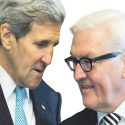Missing: A white paper on security

Europe stands at a crossroads. Internally, populist forces question the basis of our liberal democracies and the Brexit vote has shaken the very foundations of the EU, probably the world’s most successful democratic project.
Externally, the list of challenges seems almost infinite; vast parts of the Middle East and Central Africa are held back by devastating civil wars and collapsing states. People in the Southern Neighborhood of the EU are fleeing their homes from terrorism, violence and economic hardship. The Mediterranean is facing an unprecedented humanitarian catastrophe. In the east, Russia has embarked on an expansionist foreign policy and is willing to pursue its goals by military means and the breach of international law. On top of that, Europe is confronted with a US president whose foreign policy priorities remain unclear or contradictory.
Jean Monnet, one of the founding fathers of the European Union, already knew that “people only accept change when they are faced with necessity.” The truth is that Europe has taken the easy way out for too long.
While there has been some progress in recent years, the EU’s role in security and defense matters can be summed up as “too little, too late.” For many years Europeans have overly relied on the US, expecting the world’s policeman to step in whenever necessary.
The new US administration is yet another reason to call for a paradigm shift. President Donald Trump knows the EU possesses the financial power and technological know-how to be a global player. And he does not shy away from demanding Europe’s commitment in military terms as well.
Europe must finally wake up and adapt to the new reality. It will be vital to consolidate the various defense initiatives pursued by individual EU member states – as repeatedly called for in European Council resolutions – and take concerted action towards the establishment of a European defense union. This would provide the EU with urgently needed defense capabilities. How can this be achieved?
- The EU should develop a strategic outlook that commits to common defense policy ambitions. Article 26 of the EU Treaty calls on the European Council to define the “strategic interests of the Union.”
Unfortunately, the ongoing debate surrounding the refugee crisis has shown that security threats and challenges are perceived differently across various member countries. While the Baltic states and Poland regard Russia as their prime foreign and security policy concern, southeast Europe focuses on migration from the Mediterranean. Thus, it is pivotal to define common European interests, perceptions of (possible) security threats and geographical priorities. The EU needs a European white paper that encapsulates a European vision in security and defense matters and goes beyond the current global strategy. - The EU is the world’s second largest spender in terms of defense, yet clearly fails to tap its potential. As a result of austerity measures and the political Zeitgeist, European defense budgets have been cut dramatically. Several European NATO members fall clearly short of the alliance’s two-percent budget goal (defense spending as percentage of GDP), including Germany, Europe’s economic powerhouse, with a mere 1.19 percent.
The US spends significantly more on defense than the 28 European states together. Countries falling below this threshold must gradually ramp up defense expenditures. Past operations in Libya (2011) and Chad (2008) have revealed Europe’s unpreparedness, as even France and the United Kingdom were unable to carry out military missions without US assistance. - It is necessary to avoid overcapacities and a fragmented European market. Increased collaboration regarding the development of military capabilities can significantly cut costs. There are four pragmatic ways to make the best use of public funds: collaborative armament projects, pooling, role specialization and the general reduction of redundancies.
Coordinated at the EU level, (potential) defense capabilities and the assets of each member state must be identified, adjusted and merged into one common defense plan. The ultimate goal is the ability to participate in defense operations autonomously from NATO. Member states will have to specialize in certain areas, while relinquishing capabilities in others. This requires a high level of mutual trust in a sensitive policy area. The European Defense Agency should play a crucial role in this process.
From a legal point of view, the Lisbon Treaty provides a number of possibilities to enhance European defense cooperation. Articles 42(6) and 46 foresee the use of a Permanent Structured Cooperation (PESCO) for a core group of countries to pursue a more coherent security and defense policy. PESCO is open to all EU states, which limits the danger of dividing the union. It could constitute a first, decisive step towards a more resilient European security architecture.
The introduction of EU Battlegroups (EU BG) in 2005 shows that cooperation and integration in security matters is possible, although an apparent lack of political will in certain member states still presents an impediment. EU BGs could have been valuable assets to missions in the Central African Republic, Mali, Libya or Congo but have thus far never been deployed. This policy tool must therefore be improved to include easier deployment and the assurance of long-term financing.
Europe needs to get its act together and treat Trump’s election and Brexit as a wake-up call to take charge of its own destiny. Europe must move from its current patchwork of multilateral agreements to enhanced defense cooperation. Both economically and strategically, a globally strong Europe is not a luxury but a vital necessity.
A version of this article appeared in print in February, 2017, with the headline “Defense Union”.
Alexander Graf Lambsdorff is vice president of the European Parliament and a member of the Alliance of Liberals and Democrats for Europe Group.



